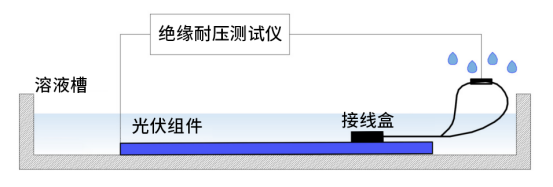
量子效率测试仪
PL/EL一体机
Sinton硅片少子寿命测试仪
Sinton硅块少子寿命测试仪
绒面反射率测试仪
3D共聚焦显微镜
清洗制绒工作站
在线四探针方阻测试仪
全自动扫描四探针方阻测试仪
在线薄膜厚度测试仪
晶化率测试仪
Horiba显微共焦拉曼光谱仪
傅里叶红外光谱仪
霍尔效应测试仪
分光光度计
全光谱椭偏仪
Horiba椭圆偏振光谱仪
TLM接触电阻率测试仪
超景深显微镜
网版智能影像测量仪
全自动影像测量仪
卧式拉力机
电池片稳态光衰老化试验箱
电池片紫外老化试验箱
电池片拉脱力综合测试仪
外观检验台
湿漏电测试系统
组件实验室EL测试仪
紫外老化试验箱
稳态光衰老化试验箱
电流连续性监测系统
PID测试系统
旁路二极管测试系统
LeTID测试系统
反向电流过载系统
脉冲电压测试系统
绝缘耐压测试仪
接地连续性测试仪
绝缘耐压接地测试仪
湿热环境试验箱
湿冻环境试验箱
热循环试验箱
动态机械载荷测试机
静态机械载荷测试机
冰雹冲击试验机
引出端强度试验机
霰弹冲击试验机
抗划伤(切割)测试机
剥离试验机
万能材料试验机(单臂)
万能材料试验机(双臂)
光伏玻璃透过率测试仪
醋酸测试试验箱
交联度测试系统
二极管接线盒综合测试仪
落球冲击试验机
半自动四探针
全自动探针式台阶仪
多通道太阳能MPPT系统
Horiba稳瞬态荧光光谱仪
钙钛矿P1激光划线测试仪
钙钛矿在线膜厚测试仪
钙钛矿工艺检测工作站
手持式IV测试仪
便携式EL测试仪
手持热成像测试仪
户外组件IV测试仪
户外组件多通道测试系统
光伏逆变器电能质量测试仪
无人机EL检测仪
IEC61215 标准下的湿漏电测试评估组件绝缘性能
日期:2024-09-14浏览量:70
随着光伏组件应用场景持续增加,其所面临的环境挑战也越来越多。组件长期在户外运行,雨、雾、露水、融雪等环境考验不可避免,因此组件在潮湿环境下的绝缘性能对其安全性和可靠性至关重要。湿漏电测试能够及时发现潜在的绝缘问题,防止因湿气侵入导致的腐蚀和漏电,避免安全事故的发生。美能湿漏电测试系统,通过先进的测试方法和严格标准,有效评估组件在潮湿环境下的绝缘性能。
湿漏电测试的标准
光伏组件湿漏电测试遵循IEC 61215标准中的MQT 15和IEC 61730标准中的MST17,这些标准规定了测试的具体条件、参数和方法,确保测试结果的可靠性。
湿漏电测试的设备构成

设备构成包括绝缘水槽及支架、控制盒、绝缘耐压测试仪、控制盒、电导率测试仪等,这些设备共同工作,模拟潮湿环境,检测组件的绝缘性能。
湿漏电测试的方法和步骤
测试前准备:
√ 一个绝缘浅槽或容器,其尺寸应足够大到能将组件及边框水平放入其中,采用绝缘材料制成
√ 水槽内必须含有水和添加剂的溶液,其最大电阻率为3500Ω.cm
√ 控温系统:采用加热制冷一体机,确保实验水温恒定在22℃±2°C
√ 喷淋设备装满相同的溶液
√ 直流电源及绝缘电阻测量仪

湿漏电流试验示意图
测试步骤:
Ø将光伏组件浸入溶液中,溶液的深度应足以覆盖除接线盒入口以外的所有表面,电缆必须喷洒水溶液。如果组件配有连接器,则在测试过程中应对连接器进行喷涂。
Ø使用合适的接头将待测组件短接后与测试仪的正极相连接,将绝缘测试仪的负极输出线同水槽引出的导线相连接。
Ø对直流电源施加电压,以不超过500v/s的速度增加至500v或组件的最大额定系统电压,保持2min,然后测量绝缘电阻。
Ø将绝缘测试仪的正极与组件短接的转接头接到边框上,等待5-10s,以释放组件的内部电压,放电完毕。
IEC 61215标准要求:
1、对于面积小于0.1㎡的组件绝缘电阻不小于400MΩ
2、对于面积大于0.1㎡的组件,测试绝缘电阻乘以组件面积应不小于40MΩ·㎡
湿漏电测试的重要性
光伏组件在潮湿环境下的绝缘性能对其安全性和可靠性至关重要。湿漏电测试能够及时发现潜在的绝缘问题,防止因湿气侵入导致的腐蚀和漏电,避免安全事故的发生。此外,定期进行湿漏电测试还可以延长组件的使用寿命,提高整体效率。
美能湿漏电测试系统
联系电话:400 008 6690
美能湿漏电测试系统ME-PV-WLC,测试组件在潮湿工作条件下的绝缘性能,检测雨、雾、露水或溶雪的湿气是否进入组件内部电路的工作部分,对其造成腐蚀、漏电、造成非安全事故。
■ 温控系统可精准控制水温
■ 适用标准:符合IEC61215-MQT15条款 和IEC61730-MST17条款
■ 绝缘水槽:PP材质,体积可定制,内部配有搁架
综上所述,湿漏电测试是对太阳能光伏组件进行的一项重要的电气测试,以评估其抗湿气侵入性。美能湿漏电测试系统,遵守IEC 61215等标准,制造商可以确保太阳能光伏组件的质量和可靠性,为用户提供高效和持久的可再生能源解决方案。




































































